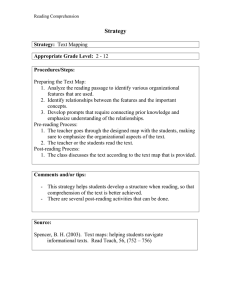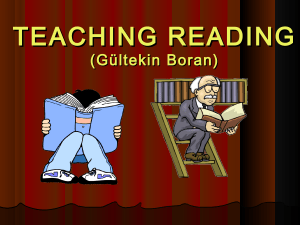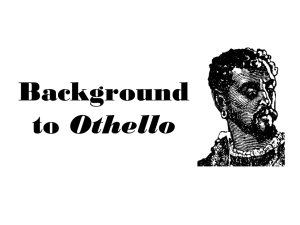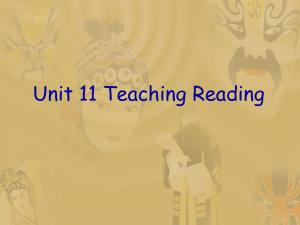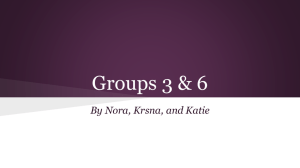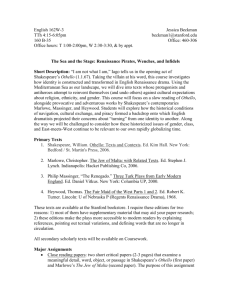NCS CAPS ORIENTATION
advertisement
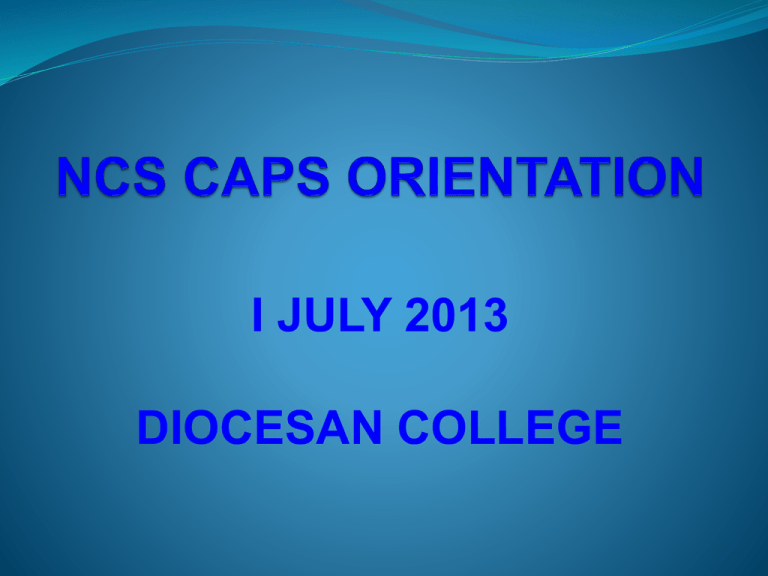
I JULY 2013 DIOCESAN COLLEGE Reading and Viewing Language structures and conventions with particular reference to Paper Two (Literature) CAPS Document pages 22 – 28 Pre-reading / Reading / Post-reading THE LITERATURE PAPER General issues: 1. Contact time with the actual texts: candidates must be more familiar with the texts than with the filmed versions 2. texts must be contextualised (PRE-READING ACTIVITIES) The American Dream / the Roaring Twenties for “The Great Gatsby” the Russian Revolution for “Animal Farm” South African history, particularly with reference to Protest poetry The Norton Anthology of Poetry defines a protest poem as “An attack, sometimes indirect, on institutions or social injustices”. Steve Biko Nelson Mandela Hector Pieterson being carried by Mbuyisa Makhubo Neil Aggett Students march in Soweto, June 16, 1976 WEEPING Written by Dan Heymann (Copyright Bright Blue) I knew a man who lived in fear It was huge, it was angry, it was drawing near Behind his house, a secret place Was the shadow of the demon he could never face He built a wall of steel and flame And men with guns, to keep it tame Then standing back, he made it plain That the nightmare would never ever rise again But the fear and the fire and the guns remain It doesn’t matter now It’s over anyhow He tells the world that it’s sleeping But as the night came round I heard its lonely sound It wasn’t roaring, it was weeping And then one day the neighbours came They were curious to know about the smoke and flame They stood around outside the wall But of course there was nothing to be heard at all "My friends," he said, "We’ve reached our goal The threat is under firm control As long as peace and order reign I’ll be damned if I can see a reason to explain Why the fear and the fire and the guns remain" Apartheid Legislation in South Africa Prohibition of Mixed Marriages Act, Act No 55 of 1949 Group Areas Act, Act No 41 of 1950 Bantu Education Act, Act No 47 of 1953 Reservation of Separate Amenities Act, Act No 49 of 1953 Separate Representation of Voters Act, Act No 46 of 1951 The Soweto Uprising, June 16, 1976 Language structures and conventions (pages 26 – 27) 1. What is tragedy? 2. What defines a tragic character? 3. The importance of foreshadowing. 4. The key concept of irony. 5. The difference between a drama and a novel. 6. The difference between tone and mood Language structures and conventions (pages 26 – 27) In the dramas: 1. the impact of stage directions 2. the power of dramatic irony 3. the role of the soliloquy In the novels: 4. the importance of characterisation 5. the actual sequence of plot i.e. structure / organisation of text What to do with the question? Account for = Why? •Give reasons for / explain why things are as they are Discuss •Analyse, using various arguments for and against •Examine in detail, bringing in related facts or arguments What to do with the question? Comment on Relevant possibilities include: •explanation of allusions (references) or difficult words •linking with the context or main themes connotations and impressions •establish the effect / significance / irony / ambiguity / level of language etc What to do with the question? Explain? •To make clear, by means of examples or description Identify: •Give the most important characteristics of Illustrate: •Explain or make clear by concrete examples, comparisons or analogies. What to do with the question? Read ALL the questions and highlight key words: a) direction words instruct the candidate as to what to do e.g. discuss, comment on, explain, justify b) knowledge words relate to the broad area of knowledge required to answer the question c) restriction words – restrict the candidate to specific details or aspects of the broad subject area e.g. line references; “in this passage” VALID FOR THE 3 / 4 MARK QUESTIONS AND THE ESSAY QUESTION 7: ANIMAL FARM (The statement is the knowledge) The characters in the novel, Animal Farm, are so flawed that the idealism of the Seven Commandments cannot be made into a reality. In a well-constructed essay of 400 – 450 words, critically discuss (Direction) the extent to which you agree (Restriction) with this statement (Knowledge). In Chapter 9, Nick Carraway (the narrator) says: ‘They were careless people, Tom and Daisy – they smashed up things and creatures and then retreated back into their money or their vast carelessness, or whatever it was that kept them together, and let other people clean up the mess they had made.’ Critically discuss the validity of the narrator’s comment in the wider context of the novel. Post-reading Problems 1. Rewriting the contextual passage as the essay 2. “Creative” essays 3. Mixing of texts and genres 4. Inappropriate language / SMS speak 5. Statements made without substantiation or evidence from text (but from film) 6. Story telling (description) versus analysis (discussion) Post-reading Problems 7. Past tense instead of present tense 8. No differentiation between title and protagonist e.g. Othello 9. Misspelling of characters’ names: Diasy, James Guts, Orthella, Desdimona, Desderoma, Desdimonia, Destimona, Riderago, Mertile, Mertill, Murtil 10. Misspelling in general: hankershiff, hangerchief, hankishift; tradgedy; soliloquay Just for fun ... or not!! Tom belives that marraige is only vowels The sheeps are stoopid Desdamona is a young vinecian hairess Dr Eckleberg is the doctor that delivered Tom and Gatsby’s baby Othello becomes one of Iago’s porns Othello is the left tendant of Venus There is a higher archy in Venis Orthello was angered by Destimona’s infertility Ijago awcastrated the hole thing
